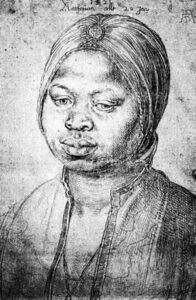Franz Kröger
The First Picture of an African Woman
In 1521 Albrecht Dürer (born 21 May 1471 in Nürnberg, Germany, died 6 April 1528 in Nürnberg), perhaps the greatest German artist of his time, created the portrait of an African woman called Katharina. She was a servant to Joãn Brandão, the head of the commercial metropolis in Antwerp, Flanders (today Belgium).
Dürer’s silver pencil drawing represents the earliest portrait of an African woman in the European history of art. On his journey to Flanders, the artist supplemented his travel budget by drawing people and then selling them these portraits. This picture of the African woman, however, he kept for himself as a memory.
Katharina looks very modest, perhaps even a little shy, for it was probably quite unusual for her to have piqued the interest of a renowned artist. She is dressed like a common European woman of the time. There are no exotic traits as they appear in later European pictures of Africans, and even today the viewer has sympathetic feelings towards the woman.
© (Picture): Raffaello Bencini, Galleria degli Uffizi, Florence
Source of the text: R. Stiftel, Der Patriot (Lippstadt) 28 August 2021

I uploaded the picture with a text similar to the one above on several Bulsa Facebook groups. The comments that followed shared one theme in particular: How did Africans get to Europe at such an early time? I could not answer the questions quite clearly, and there were certainly different possibilities. In Catherine’s case, it is likely that she arrived with returning Portuguese sailors who were the first to have contact with sub-Saharan Africa. It is also difficult to determine what status these Africans had in Europe. To simply call them all slaves, immigrants seeking work in Europe or remnants of earlier African conquests of Europe (the name Hannibal is mentioned) is surely wrong.
Some of them or their descendants managed to make a name for themselves as, for example, authors or politicians. Two posts by Samuel Abem deal with this issue in more detail. His statements and some of the questions would be worth exploring further:
Franz, yes certainly true about these ones mentioned – Anton Wilhelm [Wilhelm] Amo, Aleksandr Sergeeyevich Pushkin, Alexander Dumas (who also visited Akuse, Gold Coast), Lady Margaret, just to mention a few. But sincerely, information on slaves as domestic servants and field workers in Europe, particularly in Germany, the Nordic/Scandinavian countries and Eastern Europe, are surprisingly scanty.
What could account for this? Or Europe didn’t take interest in them? Scratched information says a good number of last-minute slaves bought by a merchant were dumped at the Russian seaports around Abkhazia/Chechnya/Ingushetia/Ossetia. It is strange for Denmark and the Nederland which engaged and held the highest stake in the trade to register a null record of descendants in their societies.
Saudi Arabia, for instance, has several of them some of them, including their presence in the Middle East and in several towns in Palestine. Of course, their presence in the USA (strangely not in the entire North America), the Caribbean and Central America, are politely ignored. Yes, not to forget Brazil. But in Argentina, Paraguay and Uruguay, the strange story reappears: records on African slaves are mute.
- Editorial
- Events
- Ghanatta Ayaric: Prof. S. Abanteriba awarded Medal of the Order of Australia (OAM)
- Franz Kröger House – Azantilow Senior High School, Sandema
- Franz Kröger: The Parliamentary and Presidential Elections 2020
- Franz Kröger, Robert Asekabta and Kennedy Azantilow : Electing New Bulsa Chiefs (2021-2022): Qualifications of a chief, elections in Fumbisi, Doninga, Kadema and Bachonsa
- Kennedy Azantilow and others: Feok Festival (and Associated Events) 2022
- Augustine Atano: Feok Festival 2020 (Review)
- Augustine Atano: The duration of the Feok Festival
- Augustine A. Atano: Feok Festival 2021 (Review)
- Kennedy Azantilow: Feok Festival 2022
- Franz Kröger: Who on Earth is Interested in the Bulsa?
- Franz Kröger: Obituaries
- Margaret Arnheim: Maaka in Buluk
- Martin Anbegwon Atuire: Bleeding Palimsests: Heritage Tourism…
- Kwesi Amoak: Review of Dr. Caesar Atuire’s “Philosophical Underspinnings of an African Legal System
- Joseph Aduedem: A Stranger in Her Own Land – The Position of Women in Bulsa Society
- Joseph Aduedem: Kisuta (taboos): Their Origins and Significance among the Bulsa
- Joseph Aduedem: Abunoruk maari Asuom / Abunoruk helped Asuom
- Joseph Aduedem: Yog Wiik
- Franz Kröger: The First Picture of an African Woman
- Franz Kröger: Recent Bulsa Publications
- Commentaries in the Internet Edition of Buluk
- Abdul-Rauf Akan-mwanatechaab: Brothers in Skirt
- John Agandin: The Fires Eat the Land at Home
- Bulsa Cuisine
- Ghanatta Ayaric: The New Masim Rice-Mill in Fumbisi